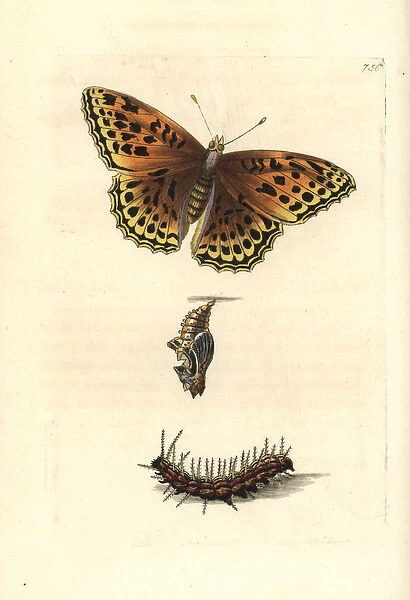Home > Animals > Insects > Butterflies > Silver-washed Fritillary
Silver-washed fritillary, Argynnis paphia
![]()

Wall Art and Photo Gifts from Mary Evans Picture Library
Silver-washed fritillary, Argynnis paphia
Silver-washed fritillary, Argynnis paphia.. Illustration drawn and engraved by Richard Polydore Nodder. Handcolored copperplate engraving from George Shaw and Frederick Nodders The Naturalists Miscellany, London, 1800
Mary Evans Picture Library makes available wonderful images created for people to enjoy over the centuries
Media ID 14218858
© Florilegius / Mary Evans
Butterfly Caterpillar Fredericknodder Georgeshaw Naturalhistory Pupa Richardpolydorenodder Thenaturalistsmiscellany
FEATURES IN THESE COLLECTIONS
> Animals
> Insects
> Butterflies
> Silver-washed Fritillary
> Europe
> United Kingdom
> England
> London
> Related Images
EDITORS COMMENTS
This exquisite handcolored copperplate engraving showcases the Silver-washed Fritillary, Argynnis paphia, a stunning and iconic European butterfly. The intricate detail in this illustration, drawn and engraved by the skilled hands of Richard Polydore Nodder, brings out the delicate beauty of this species. The Silver-washed Fritillary is known for its distinctive silver spots on its wings, which are particularly noticeable when the butterfly is at rest. The illustration also highlights the various stages of the Silver-washed Fritillary's life cycle. In the lower left corner, we see the caterpillar, which is characterized by its green body and distinctive white and black stripes. Above it, we find the pupa, or chrysalis, which is enclosed in a protective case. This stage is crucial in the metamorphosis from caterpillar to butterfly. The Silver-washed Fritillary is a large and graceful butterfly, with a wingspan of up to 10 centimeters. It is found throughout Europe, and is particularly abundant in wooded areas and along the edges of forests. This species is an important pollinator, and its larvae feed on the leaves of violets. This illustration was created in the late 18th century and was published as part of George Shaw and Frederick Nodder's The Naturalist's Miscellany, a comprehensive work on zoology and natural history. The illustration is a testament to the meticulous attention to detail and scientific accuracy that characterized natural history publications of the time. Today, it remains an invaluable resource for researchers and enthusiasts of natural history, providing a glimpse into the past and the beauty of the natural world.
MADE IN AUSTRALIA
Safe Shipping with 30 Day Money Back Guarantee
FREE PERSONALISATION*
We are proud to offer a range of customisation features including Personalised Captions, Color Filters and Picture Zoom Tools
SECURE PAYMENTS
We happily accept a wide range of payment options so you can pay for the things you need in the way that is most convenient for you
* Options may vary by product and licensing agreement. Zoomed Pictures can be adjusted in the Cart.




